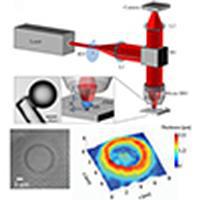当前位置:
X-MOL 学术
›
Adv. Opt. Photon.
›
论文详情
Our official English website, www.x-mol.net, welcomes your feedback! (Note: you will need to create a separate account there.)
Resolution enhancement in quantitative phase microscopy
Advances in Optics and Photonics ( IF 27.1 ) Pub Date : 2019-03-20 , DOI: 10.1364/aop.11.000135 Vicente Micó , Juanjuan Zheng , Javier Garcia , Zeev Zalevsky , Peng Gao
Advances in Optics and Photonics ( IF 27.1 ) Pub Date : 2019-03-20 , DOI: 10.1364/aop.11.000135 Vicente Micó , Juanjuan Zheng , Javier Garcia , Zeev Zalevsky , Peng Gao

|
Quantitative phase microscopy (QPM), a technique combining phase imaging and microscopy, enables visualization of the 3D topography in reflective samples, as well as the inner structure or refractive index distribution of transparent and translucent samples. Similar to other imaging modalities, QPM is constrained by the conflict between numerical aperture (NA) and field of view (FOV): an imaging system with a low NA has to be employed to maintain a large FOV. This fact severely limits the resolution in QPM up to 0.82λ/NA, λ being the illumination wavelength. Consequently, finer structures of samples cannot be resolved by using modest NA objectives in QPM. Aimed to that, many approaches, such as oblique illumination, structured illumination, and speckle illumination (just to cite a few), have been proposed to improve the spatial resolution (or the space–bandwidth product) in phase microscopy by restricting other degrees of freedom (mostly time). This paper aims to provide an up-to-date review on the resolution enhancement approaches in QPM, discussing the pros and cons of each technique as well as the confusion on resolution definition claims on QPM and other coherent microscopy methods. Through this survey, we will review the most appealing and useful techniques for superresolution in coherent microscopy, working with and without lenses and with special attention to QPM. Note that, throughout this review, with the term “superresolution” we denote enhancing the resolution to surpass the limit imposed by diffraction and proportional to λ/NA, rather than the physics limit λ/(2n med ), with n med being the refractive index value of the immersion medium.
中文翻译:

定量相位显微镜中的分辨率增强
定量相位显微镜 (QPM) 是一种结合相位成像和显微镜的技术,能够可视化反射样品中的 3D 形貌,以及透明和半透明样品的内部结构或折射率分布。与其他成像方式类似,QPM 受到数值孔径 (NA) 和视场 (FOV) 之间冲突的限制:必须采用具有低 NA 的成像系统来维持大 FOV。这一事实严重限制了 QPM 的分辨率,最高可达 0.82λ/NA,λ 是照明波长。因此,在 QPM 中使用适度的 NA 目标无法解决更精细的样本结构。为此,斜光照、结构光照、散斑光照(仅举几例)等多种方式,已经提出通过限制其他自由度(主要是时间)来提高相位显微镜中的空间分辨率(或空间带宽积)。本文旨在提供对 QPM 中分辨率增强方法的最新评论,讨论每种技术的优缺点以及对 QPM 和其他相干显微镜方法的分辨率定义声明的混淆。通过这项调查,我们将回顾相干显微镜中最有吸引力和最有用的超分辨率技术,使用和不使用镜头,并特别关注 QPM。请注意,在整个审查过程中,“超分辨率”一词表示提高分辨率以超过衍射所施加的限制并与 λ/NA 成正比,而不是物理限制 λ/(2n med ),
更新日期:2019-03-20
中文翻译:

定量相位显微镜中的分辨率增强
定量相位显微镜 (QPM) 是一种结合相位成像和显微镜的技术,能够可视化反射样品中的 3D 形貌,以及透明和半透明样品的内部结构或折射率分布。与其他成像方式类似,QPM 受到数值孔径 (NA) 和视场 (FOV) 之间冲突的限制:必须采用具有低 NA 的成像系统来维持大 FOV。这一事实严重限制了 QPM 的分辨率,最高可达 0.82λ/NA,λ 是照明波长。因此,在 QPM 中使用适度的 NA 目标无法解决更精细的样本结构。为此,斜光照、结构光照、散斑光照(仅举几例)等多种方式,已经提出通过限制其他自由度(主要是时间)来提高相位显微镜中的空间分辨率(或空间带宽积)。本文旨在提供对 QPM 中分辨率增强方法的最新评论,讨论每种技术的优缺点以及对 QPM 和其他相干显微镜方法的分辨率定义声明的混淆。通过这项调查,我们将回顾相干显微镜中最有吸引力和最有用的超分辨率技术,使用和不使用镜头,并特别关注 QPM。请注意,在整个审查过程中,“超分辨率”一词表示提高分辨率以超过衍射所施加的限制并与 λ/NA 成正比,而不是物理限制 λ/(2n med ),



























 京公网安备 11010802027423号
京公网安备 11010802027423号